Spatio-Temporal Analysis of Historical and Future Climate Data in the Texas High Plains
Abstract
:1. Introduction
2. Materials and Methods
2.1. Study Region and Climate Data
2.2. Observed Climate Data Pre-processing Using R Programming
2.3. Future Climate Data and Bias Correction Methods
2.4. Data Processing, Evaluation, and Analysis
3. Results and Discussion
3.1. Historical Climatic Conditions and Trends in the Texas High Plains
3.2. Comparisons of Observed, Raw GCM Simulated, and Bias-Corrected Climate Data
3.3. Trends of Future Climate Change in the Texas High Plains
3.4. Uncertainty of the Future Climate Change in the Texas High Plains
4. Conclusions and Remarks
Supplementary Materials
Author Contributions
Funding
Acknowledgments
Conflicts of Interest
Appendix A
Appendix B
Appendix C
References
- Parry, M.L.; Rosenzweig, C.; Iglesias, A.; Livermore, M.; Fischer, G. Effects of climate change on global food production under SRES emissions and socio-economic scenarios. Glob. Environ. Chang. 2004, 14, 53–67. [Google Scholar] [CrossRef]
- Punkari, M.; Droogers, P.; Immerzeel, W.; Korhonen, N.; Lutz, A.; Venalainen, A. Climate Change and Sustainable Water Management in Central Asia; Asian Development Bank (ABD) Central and West Asia: Manila, Philippines, 2014. [Google Scholar]
- Bates, B.C.; Kundzewicz, Z.W.; Wu, S.; Palutikof, J.P. IPCC Technical Paper on Climate Change and Water; Cambridge University Press: Cambrige, UK, 2008. [Google Scholar]
- Intergovernmental Panel on Climate Change (IPCC). Climate change. Summary for Policy makers . In Climate Change 2007. The Physical Science Basis. Contribution of Working Group I to the Fourth Assessment Report of the Intergovernmental Panel on Climate; Solomon, S.D., Qin, M., Manning, Z., Chen, M., Marquis, K.B., Averyt, M., Tignor, H.L., Eds.; Cambridge University Press: Cambridge, UK, 2007. [Google Scholar]
- United States Environmental Protection Agency (USEPA). Climate Change: Basic Information. Available online: https://19january2017snapshot.epa.gov/climatechange/climate-change-basic-information_.html (accessed on 9 July 2020).
- Bourdages, L.; Huard, D. Climate Change Scenario over Ontario Based on the Canadian Regional Climate Model (CRCM4.2); Ouranos: Montreal, QU, Canada, 2010. [Google Scholar]
- Emami, F.; Koch, M. Modeling the Impact of Climate Change on Water Availability in the Zarrine River Basin and Inflow to the Boukan Dam, Iran. Climate 2019, 7, 51. [Google Scholar] [CrossRef] [Green Version]
- Henderson, B.; Cacho, O.J.; Thornton, P.; Van Wijk, M.; Herrero, M. The economic potential of residue management and fertilizer use to address climate change impacts on mixed smallholder farmers in Burkina Faso. Agric. Syst. 2018, 167, 195–205. [Google Scholar] [CrossRef]
- Shahvari, N.; Khalilian, S.; Mosavi, S.H.; Mortazavi, S.A. Assessing climate change impacts on water resources and crop yield: A case study of Varamin plain basin, Iran. Environ. Monit. Assess. 2019, 191, 134. [Google Scholar] [CrossRef] [PubMed]
- Fragoso, R.M.D.S.; Noéme, C.J.D.A. Economic effects of climate change on the Mediterranean’s irrigated agriculture. Sustain. Account. Manag. Policy J. 2018, 9, 118–138. [Google Scholar] [CrossRef]
- Weeks, J.B. High plains regional aquifer study. In Regional Aquifer-System Analysis Program of the US Geological Survey of Projects, 1978–1984; Sun, R.J., Ed.; US Government Printing Office: Washington, DC, USA, 1986. [Google Scholar]
- Allen, V.; Brown, C.; Segarra, E.; Green, C.; Wheeler, T.; Acosta-Martínez, V.; Zobeck, T. In search of sustainable agricultural systems for the Llano Estacado of the U.S. Southern High Plains. Agric. Ecosyst. Environ. 2008, 124, 3–12. [Google Scholar] [CrossRef] [Green Version]
- Webb, W.P. The Great Plains; Ginn and Co.: New York, NY, USA, 1931. [Google Scholar]
- Araya, A.; Kisekka, I.; Lin, X.; Prasad, P.V.; Gowda, P.; Rice, C.; Andales, A. Evaluating the impact of future climate change on irrigated maize production in Kansas. Clim. Risk Manag. 2017, 17, 139–154. [Google Scholar] [CrossRef]
- Cotterman, K.; Kendall, A.D.; Basso, B.; Hyndman, D.W. Groundwater depletion and climate change: Future prospects of crop production in the Central High Plains Aquifer. Clim. Chang. 2017, 146, 187–200. [Google Scholar] [CrossRef]
- Islama, A.; Ahuja, R.L.; Garciab, L.A.; Ma, L.; Saseendran, A.S.; Trout, T.J. Modeling the impacts of climate change on irrigated maize production in the Central Great Plains. Agric. Water Manag. 2012, 110, 94–108. [Google Scholar] [CrossRef]
- Bassu, S.; Brisson, N.; Durand, J.L.; Boote, K.; Lizaso, J.; Jones, J.W.; Rosenzweig, C.; Ruane, A.C.; Adam, M.; Baron, C.; et al. How do various maize crop models vary in their responses to climate change factors? Glob. Chang. Biol. 2014, 20, 2301–2320. [Google Scholar] [CrossRef]
- Crops and Plants. Available online: http://www.nass.usda.gov/ (accessed on 6 May 2013).
- Araya, A.; Hoogenboom, G.; Luedeling, E.; Hadgu, K.M.; Kisekka, I.; Martorano, L.G. Assessment of maize growth and yield using crop models under present and future climate in southwestern Ethiopia. Agric. For. Meteorol. 2015, 252–265. [Google Scholar] [CrossRef]
- Modala, N.R.; Ale, S.; Goldberg, D.W.; Olivares, M.; Munster, C.L.; Rajan, N.; Feagin, R.A. Climate change projections for the Texas High Plains and Rolling Plains. Theor. Appl. Clim. 2016, 129, 263–280. [Google Scholar] [CrossRef]
- Williams, A.A.; White, N.; Mushtaq, S.; Cockfield, G.; Power, B.; Kouadio, L. Quantifying the response of cotton production in eastern Australia to climate change. Clim. Chang. 2014, 129, 183–196. [Google Scholar] [CrossRef]
- Yang, M.; Xiao, W.; Zhao, Y.; Li, X.; Huang, Y.; Lü, F.; Hou, B.; Li, B. Assessment of Potential Climate Change Effects on the Rice Yield and Water Footprint in the Nanliujiang Catchment, China. Sustainability 2018, 10, 242. [Google Scholar] [CrossRef] [Green Version]
- Gharbia, S.; Gill, L.; Johnston, P.; Pilla, F. Multi-GCM ensembles performance for climate projection on a GIS platform. Model. Earth Syst. Environ. 2016, 2, 102. [Google Scholar] [CrossRef] [Green Version]
- Stewart, B.A.; Steiner, J.L. Water-use efficiency. In Dryland Agriculture: Strategies for Sustainability; Singh, R.P., Parr, J.F., Stewart, B.A., Eds.; Springer: New York, NY, USA, 1990; pp. 151–173. [Google Scholar]
- USDA-NRCS. The Soil Orders of Texas. Available online: https://www.nrcs.usda.gov/wps/portal/nrcs/detail/tx/home/?cid=nrcs144p2_003094 (accessed on 1 August 2019).
- Marek, T.H.; Porter, D.O.; Gowda, P.H.; Howell, T.A.; Moorhead, J.E. Assessment of Texas Evapotranspiration (ET) Networks, Final Report to the Texas Water Development Board for Contract. Available online: https://www.twdb.texas.gov/publications/reports/contracted_reports/doc/0903580904_evapotranspiration.pdf (accessed on 25 July 2020).
- Moorhead, J.E. Crop-Specific Drought Indices for Groundwater Management in the Texas High Plains, Master’s Thesis, West Texas A&M University, Canyon, TX, USA, 2012. [Google Scholar]
- American Society of Civil Engineers-Environmental & Water Resources Institute (ASCE-EWRI). The ASCE Standardized Reference Evapotranspiration Equation. Technical Committee report to the Environmental and Water Resources Institute of the American Society of Civil Engineers from the Task Committee on Standardization of Reference Evapotranspiration; ASCE-EWRI: Reston, VA, USA, 2005; p. 173. [Google Scholar]
- Reclamation. Downscaled CMIP3 and CMIP5 Climate Projections: Release of Downscaled CMIP5 Climate Projections, Comparison with Preceding Information, and Summary of User Needs. U.S. Department of the Interior, Bureau of Reclamation. Available online: http://gdo-dcp.ucllnl.org/downscaled_cmip_projections/techmemo/downscaled_climate.pdf (accessed on 5 August 2019).
- Bellamy, S.; Boyd, D.; Minshall, L. Determining the Effect of Climate Change on the Hydrology of the Grand River Watershed; Cambridge University Press: Cambridge, UK, 2002. [Google Scholar]
- Wu, Y.; Liu, S.; Gallant, A.L. Predicting impacts of increased CO2 and climate change on the water cycle and water quality in the semiarid James River Basin of the Midwestern USA. Sci. Total Environ. 2012, 430, 150–160. [Google Scholar] [CrossRef] [PubMed] [Green Version]
- Chen, Y.; Marek, G.W.; Marek, T.H.; Moorhead, J.E.; Heflin, K.R.; Brauer, D.K.; Gowda, P.; Srinivasan, R. Simulating the impacts of climate change on hydrology and crop production in the Northern High Plains of Texas using an improved SWAT model. Agric. Water Manag. 2019, 221, 13–24. [Google Scholar] [CrossRef]
- Riahi, K.; Grübler, A.; Nakićenović, N. Scenarios of long-term socio-economic and environmental development under climate stabilization. Technol. Forecast. Soc. Chang. 2007, 74, 887–935. [Google Scholar] [CrossRef]
- Clarke, L.E.; Edmonds, J.A.; Jacoby, H.D.; Pitcher, H.; Reilly, J.M.; Richels, R. Scenarios of Greenhouse Gas Emissions and Atmospheric Concentrations. Sub-Report 2.1a of Synthesis and Assessment Product 2.1; Climate Change Science Program and the Subcommittee on Global Change Research: Washington, DC, USA, 2007.
- Fujino, J.; Nair, R.; Kainuma, M.; Masui, T.; Matsuoka, Y. Multi-gas Mitigation Analysis on Stabilization Scenarios Using Aim Global Model. Energy J. 2006, 27, 343–354. [Google Scholar] [CrossRef]
- Hijioka, Y.; Matsuoka, Y.; Nishimoto, H.; Masui, T.; Kainuma, M. Global GHG emission scenarios under GHG concentration stabilization targets. J. Glob. Environ. Eng. 2008, 1, 97–108. [Google Scholar]
- Smith, S.J.; Wigley, T.M.L. Multi-Gas Forcing Stabilization with Minicam. Energy J. 2006, 27, 373–392. [Google Scholar] [CrossRef]
- Wise, M.; Calvin, K.; Thomson, A.; Clarke, L.; Bond-Lamberty, B.; Sands, R.; Smith, S.J.; Janetos, A.; Edmonds, J. Implications of Limiting CO2 Concentrations for Land Use and Energy. Science 2009, 324, 1183–1186. [Google Scholar] [CrossRef] [PubMed]
- Christensen, J.H.; Boberg, F.; Christensen, O.B.; Lucas-Picher, P. On the need for bias correction of regional climate change projections of temperature and precipitation. Geophys. Res. Lett. 2008, 35, 20709. [Google Scholar] [CrossRef]
- Teutschbein, C.; Seibert, J. Regional Climate Models for Hydrological Impact Studies at the Catchment Scale: A Review of Recent Modeling Strategies. Geogr. Compass 2010, 4, 834–860. [Google Scholar] [CrossRef] [Green Version]
- Teutschbein, C.; Seibert, J. Bias correction of regional climate model simulations for hydrological climate-change impact studies: Review and evaluation of different methods. J. Hydrol. 2012, 456, 12–29. [Google Scholar] [CrossRef]
- Varis, O.; Kajander, T.; Lemmela, R. Climate and Water: From Climate Models to Water Resources Management and Vice Versa. Clim. Chang. 2004, 66, 321–344. [Google Scholar] [CrossRef]
- Johnson, F.; Sharma, A. Accounting for interannual variability: A comparison of options for water resources climate change impact assessments. Water Resour. Res. 2011, 47, 04508. [Google Scholar] [CrossRef]
- Rojas, R.; Feyen, L.; Dosio, A.; Bavera, D. Improving pan-European hydrological simulation of extreme events through statistical bias correction of RCM-driven climate simulations. Hydrol. Earth Syst. Sci. 2011, 15, 2599–2620. [Google Scholar] [CrossRef] [Green Version]
- Sennikovs, J.; Bethers, U. Statistical downscaling method of regional climate model results for hydrological modelling. In 18th World IMACS Congress and MODSIM09 International Congress on Modelling and Simulation; Anderssen, R.S., Braddock, R.D., Newham, L.T.H., Eds.; Modelling and Simulation Society of Australia and New Zealand and International Association for Mathematics and Computers in Simulation: Cairns, Australia, 2009; pp. 3962–3968. [Google Scholar]
- Sun, F.; Roderick, M.L.; Lim, W.H.; Farquhar, G.D. Hydroclimatic projections for the Murray-Darling Basin based on an ensemble derived from Intergovernmental Panel on Climate Change AR4 climate models. Water Resour. Res. 2011, 47. [Google Scholar] [CrossRef]
- Lenderink, G.; Buishand, A.; Van Deursen, W. Estimates of future discharges of the river Rhine using two scenario methodologies: Direct versus delta approach. Hydrol. Earth Syst. Sci. 2007, 11, 1145–1159. [Google Scholar] [CrossRef]
- Rathjens, H.; Bieger, K.; Srinivasan, R.; Chaubey, I.; Arnold, J.G. CMhyd User Manual. Available online: https://swat.tamu.edu/media/115265/bias_cor_man.pdf (accessed on 1 August 2019).
- Holman, D.; Sridharan, M.; Gowda, P.; Porter, D.; Marek, T.; Howell, T.; Moorhead, J. Gaussian process models for reference ET estimation from alternative meteorological data sources. J. Hydrol. 2014, 517, 28–35. [Google Scholar] [CrossRef]
- Lafon, T.; Dadson, S.; Buys, G.; Prudhomme, C. Bias correction of daily precipitation simulated by a regional climate model: A comparison of methods. Int. J. Clim. 2012, 33, 1367–1381. [Google Scholar] [CrossRef] [Green Version]
- Ines, A.V.M.; Hansen, J. Bias correction of daily GCM rainfall for crop simulation studies. Agric. For. Meteorol. 2006, 138, 44–53. [Google Scholar] [CrossRef] [Green Version]
- Block, P.J.; Filho, F.D.A.S.; Sun, L.; Kwon, H.-H. A Streamflow Forecasting Framework using Multiple Climate and Hydrological Models. Jawra J. Am. Water Resour. Assoc. 2009, 45, 828–843. [Google Scholar] [CrossRef]
- Teutschbein, C.; Seibert, J. Is bias correction of regional climate model (RCM) simulations possible for non-stationary conditions? Hydrol. Earth Syst. Sci. 2013, 17, 5061–5077. [Google Scholar] [CrossRef] [Green Version]
- Crimmins, A.; Balbus, J.; Gamble, J.; Beard, C.; Bell, J.; Dodgen, D.; Eisen, R.; Fann, N.; Hawkins, M.; Herring, S.; et al. The Impacts of Climate Change on Human Health in the United States: A Scientific Assessment; U.S. Global Change Research Program: Washington, DC, USA, 2016; p. 312.
- Centers for Disease Control and Prevention U.S. Environmental Protection Agency National Oceanic; Atmospheric Agency American Water Works Association. When Every Drop Counts: Protecting Public Health during Drought Conditions—A Guide for Public Health Professionals; U.S. Department of Health and Human Services: Atlanta, GA, USA, 2010.
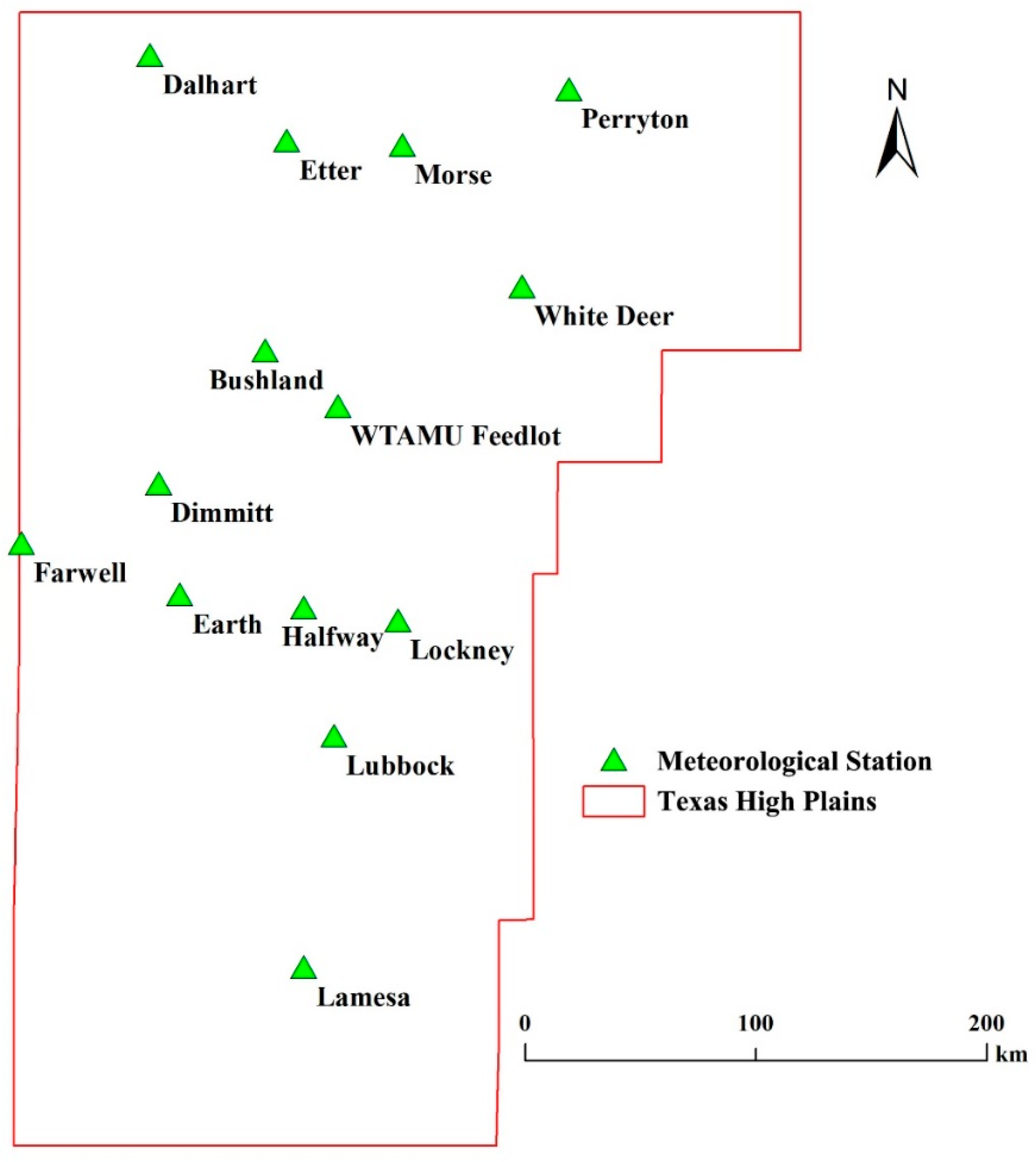

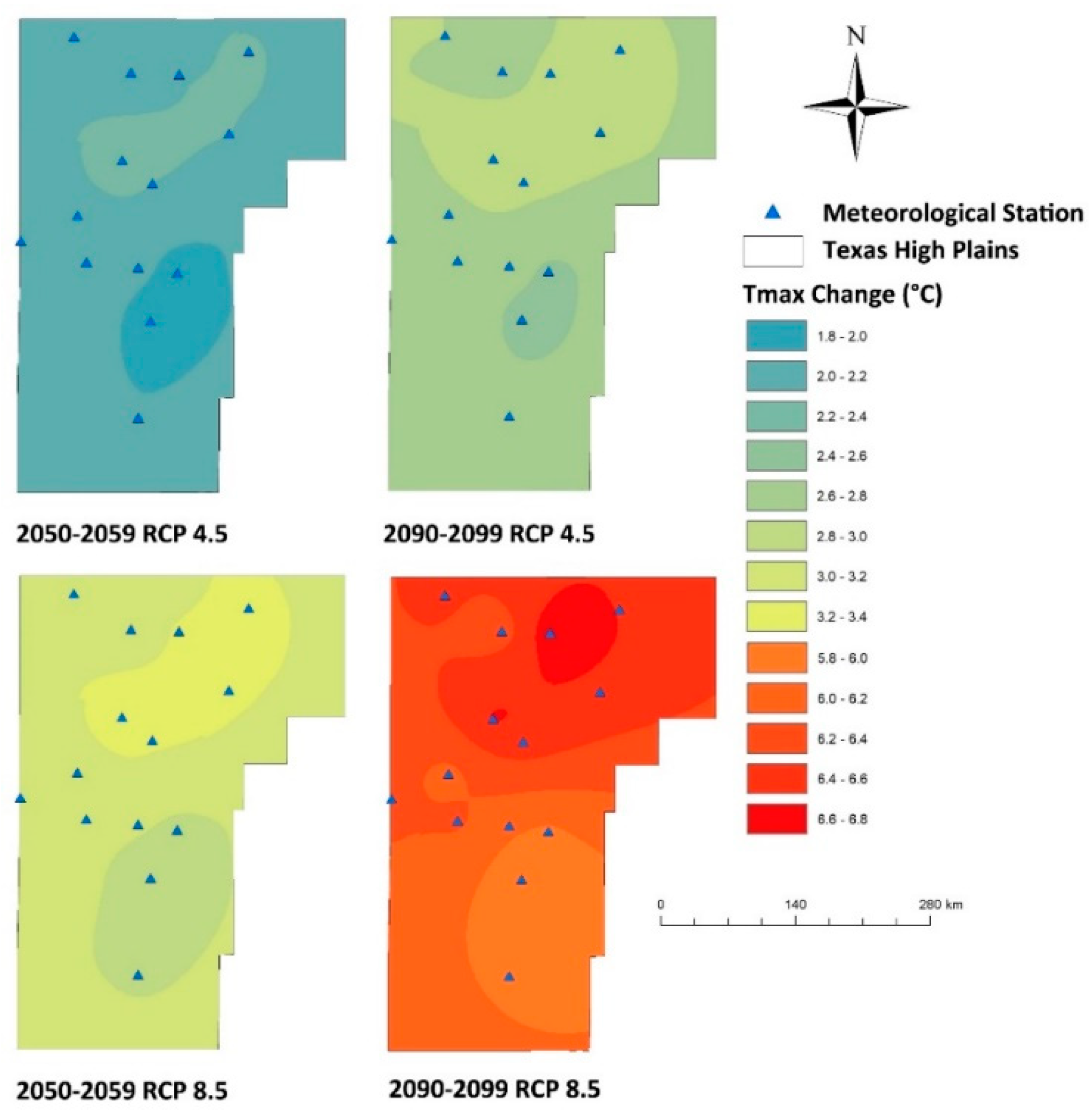
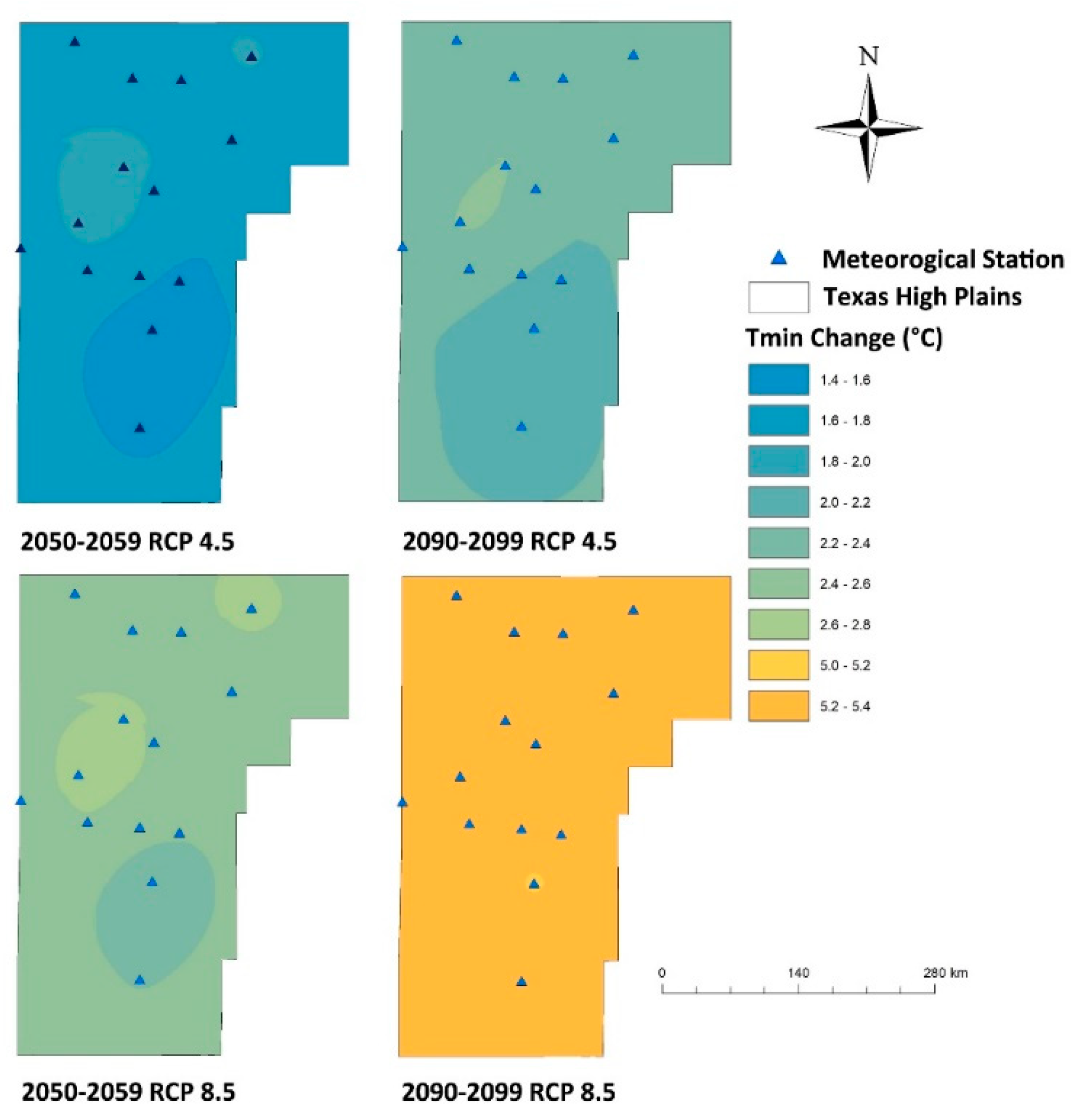
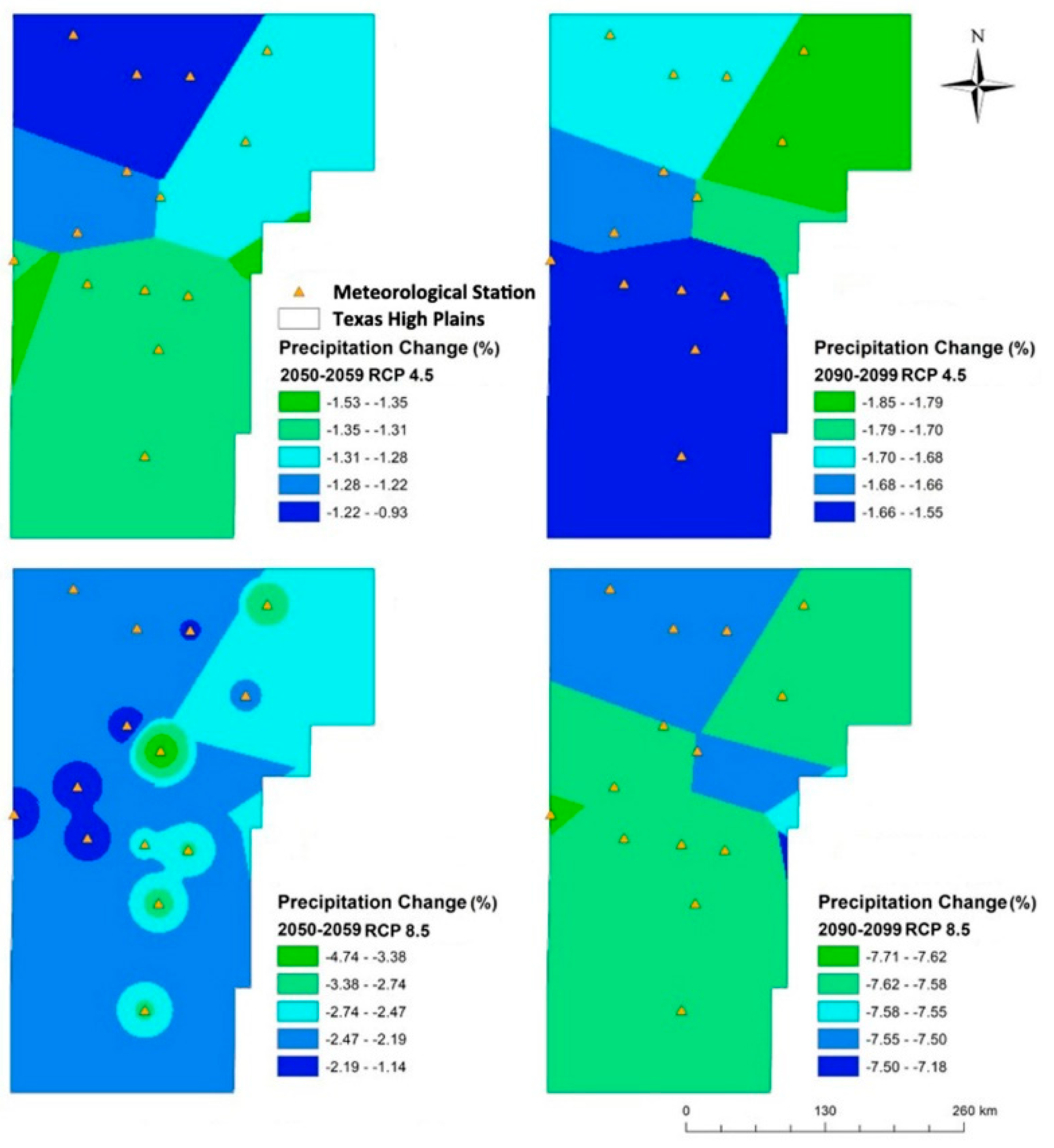

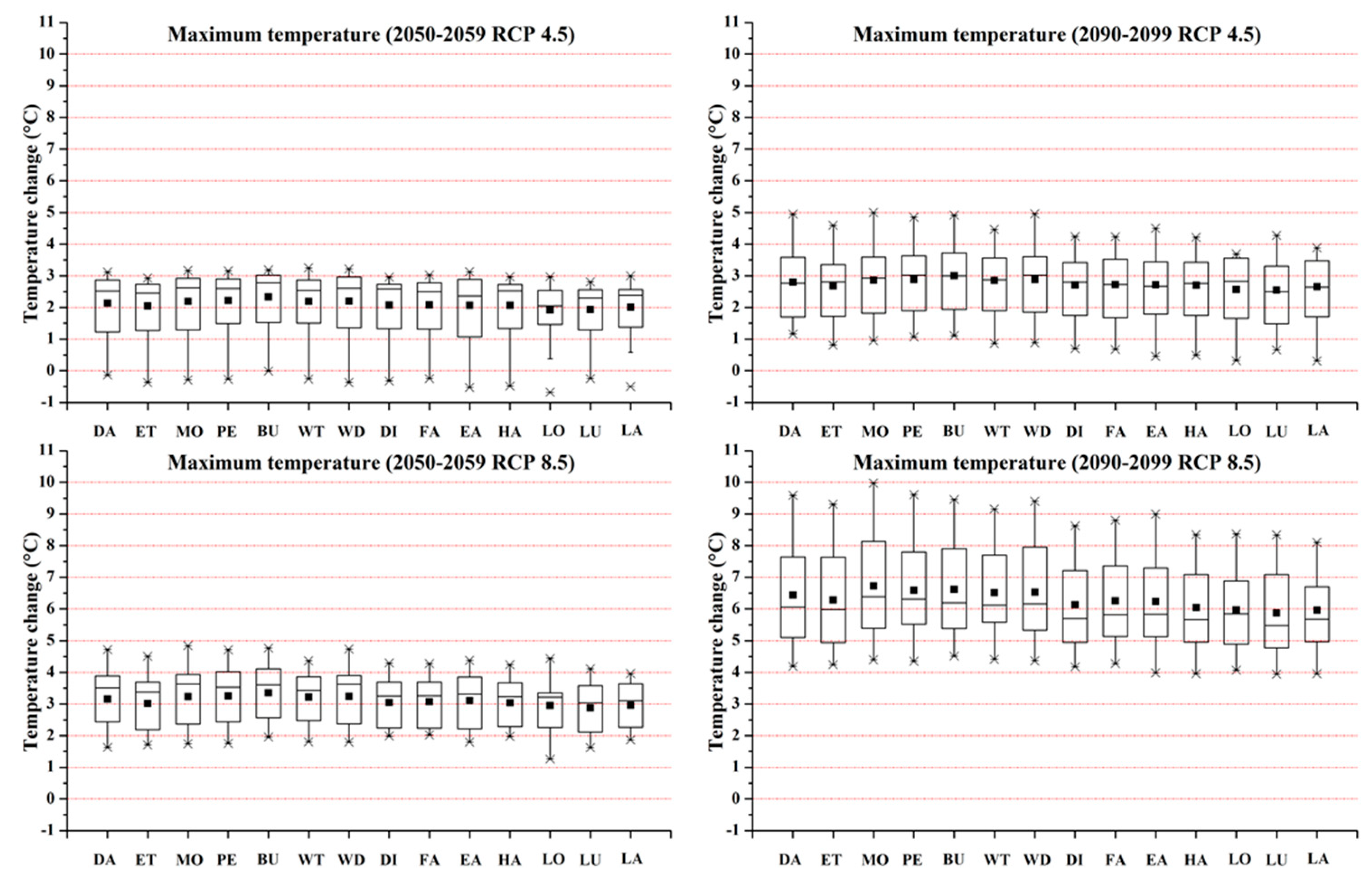
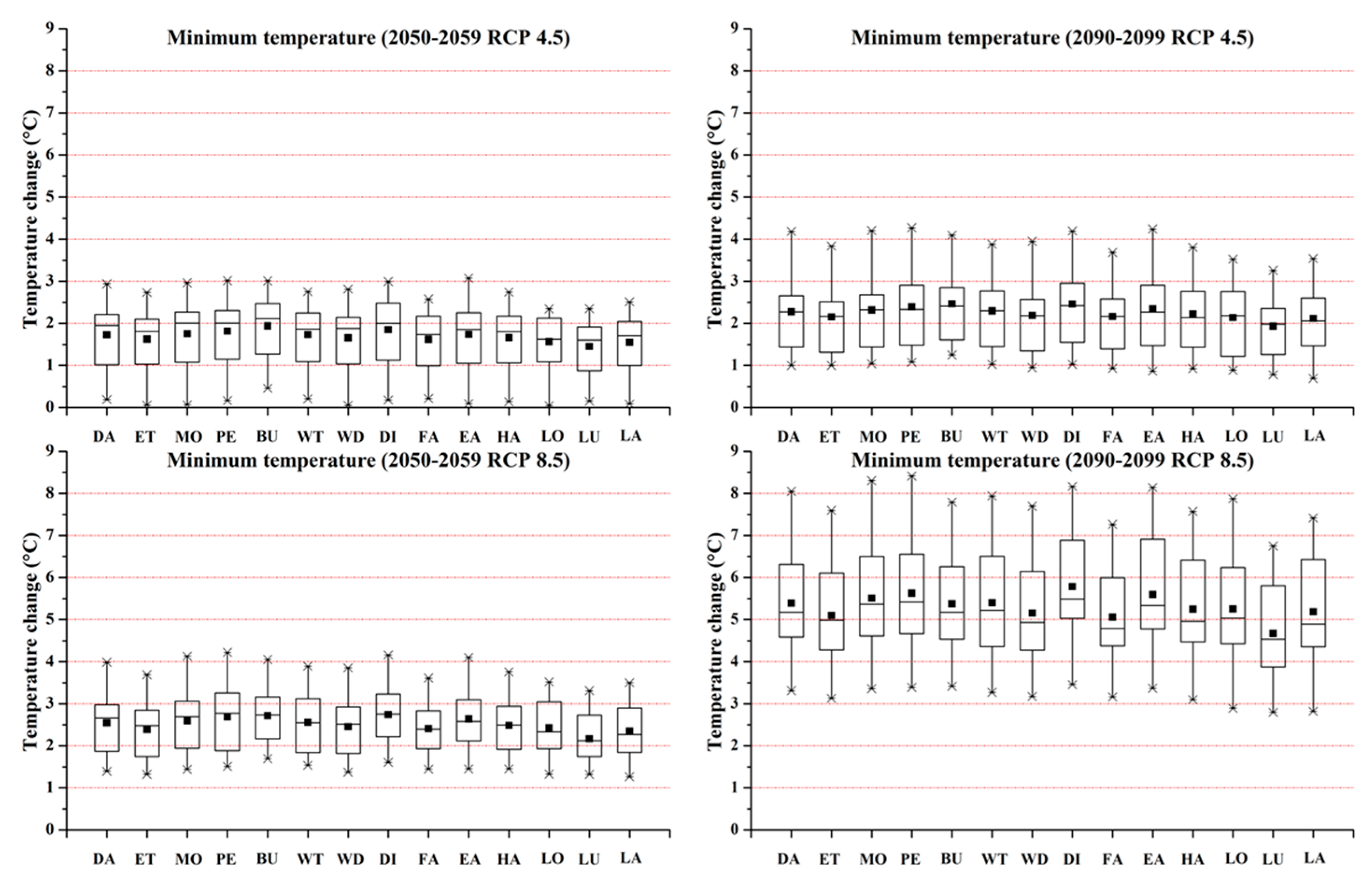
| Station | Short Name | Latitude | Longitude | Data Record | Elevation (m) |
|---|---|---|---|---|---|
| Dalhart | DA | 36°20′ N | 102°32′ W | 1995–2010 | 1223 |
| Etter | ET | 36°00′ N | 102°00′ W | 1995–2014 | 1103 |
| Morse | MO | 35°59′ N | 101°33′ W | 1992–2010 | 1006 |
| Perryton | PE | 36°12′ N | 100°54′ W | 1997–2010 | 907 |
| Bushland | BU | 35°11′ N | 102°50′ W | 1991–2014 | 1187 |
| West Texas A&M University Feedlot | WT | 34°58′ N | 101°48′ W | 2001–2014 | 1111 |
| White Deer | WD | 35°26′ N | 101°50′ W | 1995–2010 | 1012 |
| Dimmitt | DI | 34°40′ N | 102°30′ W | 1995–2010 | 1205 |
| Farwell | FA | 34°26′ N | 103°20′ W | 1997–2010 | 1240 |
| Earth | EA | 34°14′ N | 102°25′ W | 1996–2007 | 1142 |
| Halfway | HA | 34°11′ N | 101°56′ W | 1997–2014 | 1088 |
| Lockney | LO | 34°80′ N | 101°34′ W | 2006–2010 | 998 |
| Lubbock | LU | 33°41′ N | 101°49′ W | 1997–2014 | 998 |
| Lamesa | LA | 32°47′ N | 101°56′ W | 1997–2014 | 927 |
| Scenario | Radiative Forcing (W m−2) | CO2 Equivalent Concentration (ppm) | Change Rate of Radiative Forcing | Source |
|---|---|---|---|---|
| RCP 4.5 | 4.5 | 650 | Stabilizing | Clarke et al. [34]; Smith and Wigley [37]; Wise et al. [38] |
| RCP 8.5 | 8.5 | 1350 | Rising | Riahi et al. [33] |
| Meteorological Stations | GCMs | RCPs | Time Periods | Bias Correction Methods |
|---|---|---|---|---|
| 1. Dalhart | 1. access1-0 | 1. RCP 4.5 | 1. 2000–2009 | 1. No correction |
| 2. Etter | 2. bcc-csm1-1 | 2. RCP 8.5 | 2. 2050–2059 | 2. Quantile mapping for precipitation |
| 3. Morse | 3. canesm2 | 3. 2090–2099 | 3. Linear scaling for precipitation | |
| 4. Perryton | 4. ccsm4 | 4. Quantile mapping for Tmax | ||
| 5. Bushland | 5. cesm1-bgc | 5. Quantile mapping for Tmin | ||
| 6. WTAMU Feedlot | 6. cnrm-cm5 | |||
| 7. White Deer | 7. csiro-mk3-6-0 | |||
| 8. Dimmitt | 8. gfdl-esm2g | |||
| 9. Farwell | 9. gfdl-esm2m | |||
| 10. Earth | 10. inmcm4 | |||
| 11. Halfway | 11. ipsl-cm5a-lr | |||
| 12. Lockney | 12. ipsl-cm5a-mr | |||
| 13. Lubbock | 13. miroc5 | |||
| 14. Lamesa | 14. miroc-esm | |||
| 15. miroc-esm-chem | ||||
| 16. mpi-esm-lr | ||||
| 17. mpi-esm-mr | ||||
| 18. mri-cgcm3 | ||||
| 19. noresm1-m | ||||
| 14 | ×19 = 266 | ×2 = 532 | ×3 = 1596 | ×5 = 7980 |
© 2020 by the authors. Licensee MDPI, Basel, Switzerland. This article is an open access article distributed under the terms and conditions of the Creative Commons Attribution (CC BY) license (http://creativecommons.org/licenses/by/4.0/).
Share and Cite
Chen, Y.; Marek, G.W.; Marek, T.H.; Porter, D.O.; Moorhead, J.E.; Wang, Q.; Heflin, K.R.; Brauer, D.K. Spatio-Temporal Analysis of Historical and Future Climate Data in the Texas High Plains. Sustainability 2020, 12, 6036. https://doi.org/10.3390/su12156036
Chen Y, Marek GW, Marek TH, Porter DO, Moorhead JE, Wang Q, Heflin KR, Brauer DK. Spatio-Temporal Analysis of Historical and Future Climate Data in the Texas High Plains. Sustainability. 2020; 12(15):6036. https://doi.org/10.3390/su12156036
Chicago/Turabian StyleChen, Yong, Gary W. Marek, Thomas H. Marek, Dana O. Porter, Jerry E. Moorhead, Qingyu Wang, Kevin R. Heflin, and David K. Brauer. 2020. "Spatio-Temporal Analysis of Historical and Future Climate Data in the Texas High Plains" Sustainability 12, no. 15: 6036. https://doi.org/10.3390/su12156036
APA StyleChen, Y., Marek, G. W., Marek, T. H., Porter, D. O., Moorhead, J. E., Wang, Q., Heflin, K. R., & Brauer, D. K. (2020). Spatio-Temporal Analysis of Historical and Future Climate Data in the Texas High Plains. Sustainability, 12(15), 6036. https://doi.org/10.3390/su12156036





